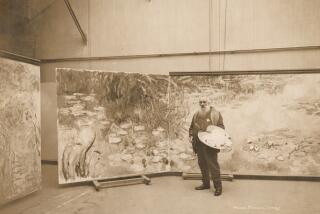Putting Cezanne on a pedestal
- Share via
Aix-en-Provence, France — TIME stopped at Les Lauves, Paul Cezanne’s studio, on Oct. 15, 1906. That was the day the Modernist master left his studio for the surrounding hills just north of Aix-en-Provence, never to return. He collapsed while working on a portrait of his gardener, Vallier, and was carried in a laundry basket to his apartment at 23 Rue Boulegon in Aix, where he died Oct. 23, 1906.
A century later, the French have declared 2006 the Year of Cezanne, www.cezanne-2006.com, and events to mark the artist’s life are planned in France and the United States.
Biggest among them is “Cezanne in Provence,” an exhibition curated by Philip Conisbee, senior curator of European paintings at the National Gallery of Art in Washington, D.C., and Denis Coutagne, conservator in chief of Aix’s Granet Museum, where Cezanne was a student. The free exhibition is to open today at the National Gallery, www.nga.gov, and closes May 7. It then moves to the Granet, where it will be on display from June 9 to Sept. 17.
There are about 115 works of Provence and its people in the exhibit at the National Gallery, including some of the artist’s best known -- “Large Bathers,” “The Artist’s Father, Reading L’Evenement,” “The Cardplayers,” “Madame Cezanne” and self-portraits.
Besides the exhibit, several sites central to Cezanne’s work and life, such as Jas de Bouffan, his family home, and the quarries at Bibemus, near Aix-en-Provence, will be open to visitors this year, and a free concert will be given by the Berliner Philharmoniker during the Festival d’Aix-en-Provence, July 2 to 22.
“Aix was the center of gravity for Cezanne, as a painter and as a person,” said Conisbee. “He was the last great artist who became deeply engaged with a specific landscape. His bond was with the land.”
Cezanne’s tomb is in Aix’s St. Pierre cemetery, although he wished to be buried on the grounds of Les Lauves. After he died, the door to Les Lauves was shut and everything inside kept just as he had left it. It’s now owned by the city and open to the public. It has become a shrine to the father of modern art, a man who, during his lifetime, was reviled as a painter and as a person.
Hanging on the studio wall is Cezanne’s paint-splattered black suit and slightly misshapen bowler hat, seen in the few existing photographs of the artist. Half-used tubes of paint, a palette and Bunsen burner, along with his walking stick and canvas bag, add to the atmosphere. The studio is at 9 Ave. Paul, Aix-en-Provence; www.atelier-cezanne.com.
For more information, contact the Aix-en-Provence Tourist Centre, 2 Place du General de Gaulle, 13100 Aix-en-Provence; www.aixenprovencetourism.com.
The Musee Granet (Place Saint Jean de Malte), where Cezanne studied as a young man, is open 9 a.m. to 7 p.m. most days and 9 a.m. to 11 p.m. Thursdays. Tickets are about $14 to $20.
More to Read
Sign up for The Wild
We’ll help you find the best places to hike, bike and run, as well as the perfect silent spots for meditation and yoga.
You may occasionally receive promotional content from the Los Angeles Times.





